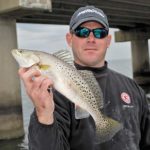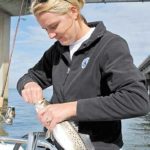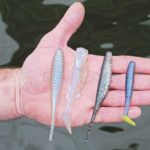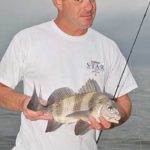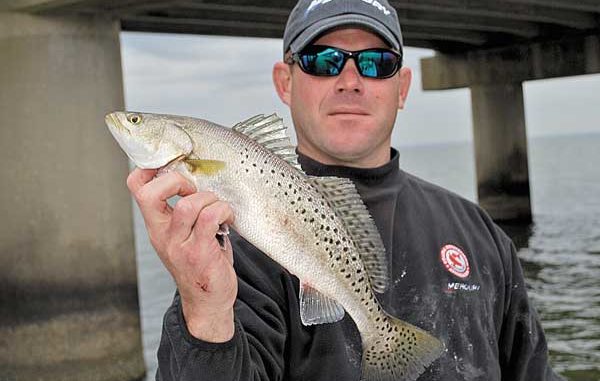
As director of the STAR tournament, Sam Barbera is ineligible to win its prizes, but that doesn’t stop him from fanatically targeting monster trout along the Causeway.
It’s a shame when a grown man starts shaking like this,” said 40-year-old Sam Barbera as he idled his fishing partner’s boat out of the Mandeville Boat Launch. A glance at his hands revealed that they were indeed shaking in anticipation.
Barbera and Julie Grunewald were heading for the Lake Pontchartrain Causeway, the pair of parallel 24-mile-long bridges connecting Metairie and Mandeville to fish for speckled trout. Both Barbera and Grunewald work for the Louisiana Coastal Conservation Association (CCA), so the day was something of a busman’s holiday.
But you would never have known it by watching Barbera.
“The Lake Pontchartrain Causeway is my favorite fishing spot,” he proclaimed, “because you never know anywhere in the lake if your next cast won’t be a new state record. I want to break into the top 10 (speckled trout records) before I die.”
Barbera regularly fishes all the lake’s bridges, but that the others can get so crowded that fishing is unpleasant.
“I like this bridge,” he said of the Causeway. “My experience is that it has bigger fish than the other bridges. I haven’t had 25 throw-backs since Dudley (Vandenborre) introduced me to the bridge in 2000.”
So addicted is Barbera to the lake and its bridges that outdoor media personality Kevin Ford has dubbed him “Prince of the Pontchartrain.” This was after Barbera modestly deferred the title of “King” to his friend and fishing guide Vandenborre.
A little over a mile from the boat launch, Barbera and Grunewald began probing the bridge’s pilings with soft plastics on jigheads. Barbera piloted the boat with his trolling motor to allow him to fish both upcurrent and downcurrent on both spans, as well as under the spans. He was looking for a pattern about where the speckled trout were holding and feeding.
With a distinctive style, Barbera arched his baitcasting rod backwards over his head at the end of each cast to strip enough braided line off of the reel to create slack line. This allowed the bait to free-fall naturally. When he uses one of his rods loaded with monofilament line, he strips the slack out by hand.
“One of the biggest mistakes people make when fishing the bridges,” he tutored, “is to engage the reel as soon as the bait hits the water. Without slack, by the time the bait falls the 12 to 14 feet to the bottom, it is away from the piling.”
“Aggrahh,” he uttered a primal scream and shook the rod violently. “I always miss the first fish of the day.”
His hands were still shaking. Grunewald had already quietly put one in the boat.
Three casts later — bam! — Barbera hooked and landed his first speck. Still not settled down to business, he let the fish twist itself from his grasp and flip all over his hands and arms before he pinning it to his chest — to Grunewald’s vast amusement.
With opening jitters gone, Barbera became a picture of intense concentration, making focused predatory casts and striking quickly and viciously at each bump. Fueled by Copenhagen snuff and Diet Coke, the hyperkinetic angler tossed off a steady stream of one-liners: “He pulled my pants down,” after a strike and a miss. “That’s why I can’t sleep at night,” after a hook-up on a good fish.
Fishing at the Causeway is noisy — really noisy. A steady clonk, clonk, clonk reverberates under the bridge from cars passing overhead.
“You really become one with Mother Nature,” joked Grunewald in response to the noise.
Hailing originally from Marksville, she admitted she never fished in salt water before going to work for CCA.
“This is definitely different than cane poles and sac-a-lait,” she said with a grin.
Now, she and her husband Hampton fish the Causeway regularly in their new 24-foot Champion.
“It’s close to Baton Rouge and easy to make a day trip,” she said.
While the trout never came in a flurry, Barbera and Grunewald steadily picked up fish after fish.
“Fishing the Causeway isn’t for those who want to catch a limit of any size fish and get off the water by 9 a.m.,” Barbera said. “Action here is slow but steady, but the fish are nice-sized.”
Barbera fishes for speckled trout along the Causeway for an estimated 40 of his 65 days or so on the water each year. He says that, by far, the most common bait he uses is the Deadly Dudley Terror Tail Jr. in midnight blue moon with a chartreuse tail.
Other lures used include Deadly Dudley Straight Tails and Bay Choveys, Bass Assassin Straight Tails, Norton Sand Eels and “a little Berkley Gulp! every now and then.” Other favorite colors are regular blue moon, salt and pepper and root beer.
He offered the typical advice for fishing soft plastics — use bright colors on clear days and dark colors on overcast days.
“If you have confidence in a brand or color from another area, use it,” he recommended.
More important than color, he said, is to get the bait to the bottom. Jighead size is typically 3/8-ounce and, often, 1/2-ounce — “whatever gets it to the bottom quickly.”
Each jighead is rigged with a split-ring through its eye, one of Barbera’s secrets to getting the best movement in his lures.
As the pair fished, they picked up a surprising number of puppy drum mixed in the trout catch. Other species are not unusual in the catch along the bridge, he said. Besides black drum, redfish, white trout over 2 pounds and a surprising number of freshwater drum, also called gaspergou, will be bonus catches.
Back on talking about his equipment, Barbera explained that he prefers baitcasting reels, but will use some “egg beaters,” as he calls spinning reels, when he fishes with a Carolina rig or at the end of a long day when his tendonitis is acting up.
His choice of lines is either 30-pound braided line with 25-pound fluorocarbon leaders or 12-pound monofilament.
“With a good tide and not a lot of wind, I fish with braided lines,” he said, “because I can feel the fish better. It’s also safer because you are not as likely to lose a big fish on a piling. But mono falls quicker, so I use it on days with not much tide.”
He considers a trolling motor “a must.” Without one, a person is restricted to fishing the structure-rich areas of the bridge’s drawbridges and turnarounds.
As they fished, the pair bantered constantly, with Barbera doing most of the picking and Grunewald regularly threatening to ask him to exit her boat. When he wasn’t picking on Grunewald, Barbera produced a variety of yowls, grunts, groans and sighs, never producing the same sound twice. With each exclamation, Grunewald grinned knowingly.
Fishing with Barbera is a high-voltage experience.
Barbera prefers to position the boat so that he can retrieve his jigs downcurrent. This way, he can simply bounce the bait off the bottom and let the tidal current move it. He will sometimes, however, fish the other side of the bridge, with the advantage being that the bait stays in the strike zone longer.
His casts are usually made to drop lures as close to pilings as possible. After the lure settles to the bottom, he gives it two or three short jigs, and lets it settle again before repeating the process several times. On strong tides, he says that trout will either be right on the piling or a good ways off the piling, sometimes as much as 10 or 12 feet.
When he feels that his bait has moved out of the strike zone, he reels it in so fast that his hand is a blur.
“I want to get my bait back fast for another retrieve,” he said. “Every cast is a new day.”
Barbera does almost everything at warp speed. He doesn’t unhook a fish; he bangs the hook free with the heel of his hand. When he breaks off on a piling, he seldom takes time to retie the line, preferring instead to grab another rigged rod.
“That’s why I carry 18 poles in the boat,” he explained.
Only during the retrieve in the strike zone does he move deliberately. Then he is a picture of almost ferociously intense concentration. Although sometimes the trout really hammer the lure, more often the bite is subtle, especially in the fall season.
“It may be a slight movement sideways, a little peck or a sense of losing contact with the weight of the lure,” Barbera said. “Then you only have maybe a second and a half to set the hook before the trout feels the weight and spits the bait out.”
Barbera particularly likes to cast between sets of pilings. This is easier to do on the western span of the bridge, which has only two pilings to a set, than on the eastern span which has three.
By mid-morning, the pair had something of a pattern nailed down. Most of the specks were hanging off the northwest corner of each piling set. The ice chest filled steadily until a massive squall descending from the northwest forced Barbera and Grunewald to retire from the field of action.
Most of the day’s fishing had been done on the stretch of the bridges between four and nine miles from the north shore of the lake.
As we idled in close into the launch area, Barbera explained his view of fishing the Causeway.
“The bridges are ideal for someone like me who would rather fish all day for five nice trout than flip in 25 little ones from under a cork,” he said. “Plus it’s almost never crowded, even on weekends.”
Barbera and Grunewald quickly loaded the boat on the trailer, finishing just before they were swallowed by a black wall of rain. Back at the bridge, more than 9,000 concrete pilings stood still, behind one of which, Barbera believes, lurks the next state-record speckled trout.
